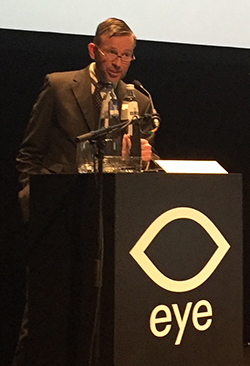EYES on Insolvency Report
One day international conference, 27 January 2017
Report by Myriam Mailly, INSOL Europe Technical Officer
Report by Myriam Mailly, INSOL Europe Technical Officer
The one-day international conference titled ‘Designing pre-insolvency proceedings of the future’ took place in Amsterdam on 27 January 2017, attended by over 250 delegates. The conference was organised by RESOR and the Business & Law Research Centre of Radboud University in cooperation with INSOL Europe and the European Commission.
The conference started with an overview of the European Commission’s draft proposal on preventive restructuring frameworks, second chance and measures to increase the efficiency of restructuring, insolvency and discharge procedures published on 22 November 2016 (hereafter ‘draft proposal’).
During the course of the conference various themes included in that draft proposal were raised from a legal, economical and financial angle. Before entering into the debate on the benefits and the weakness of the draft proposal, the question of ‘what are pre-insolvency proceedings?’ was first evoked. In particular, the normative foundations (insolvency instrument) and the objectives (any kind of restructuring including liquidation by a sale of the business as a going concern) of such kind of proceedings were highlighted. Recommendations then followed on various aspects of the preventive restructuring process as described in the draft proposal including the need to clarify the scope of early determination decisions (meaning where the court is involved before the confirmation stage). By contrast, the panelists were of the view that the draft proposal should not contain nor any mandatory prior approval of disclosure statement neither a compulsory hearing for the confirmation of the restructuring plan (the latter should be only a possibility available to the parties according to their needs).
The conference started with an overview of the European Commission’s draft proposal on preventive restructuring frameworks, second chance and measures to increase the efficiency of restructuring, insolvency and discharge procedures published on 22 November 2016 (hereafter ‘draft proposal’).
During the course of the conference various themes included in that draft proposal were raised from a legal, economical and financial angle. Before entering into the debate on the benefits and the weakness of the draft proposal, the question of ‘what are pre-insolvency proceedings?’ was first evoked. In particular, the normative foundations (insolvency instrument) and the objectives (any kind of restructuring including liquidation by a sale of the business as a going concern) of such kind of proceedings were highlighted. Recommendations then followed on various aspects of the preventive restructuring process as described in the draft proposal including the need to clarify the scope of early determination decisions (meaning where the court is involved before the confirmation stage). By contrast, the panelists were of the view that the draft proposal should not contain nor any mandatory prior approval of disclosure statement neither a compulsory hearing for the confirmation of the restructuring plan (the latter should be only a possibility available to the parties according to their needs).

The emphasis was then put on the need to clarify some issues relating to the cram-down process, and in particular the valuation of the company’s business (or assets). The difficulties relating to the cross-class cram down mechanism were evoked and led to explain why it is still an on-going debate in the US. Other aspects relating to the valuation issue were highlighted from a judicial perspective (role of the experts in the valuation process and role of courts with regard to the treatment of confidential information and the procedural means to reduce the duration of the valuation process.
There was also a focus on the fact that there may be a room for the European legislator to clarify some provisions in the draft proposal relating to the stay, the continuation of executory contracts and the protection of the (interim/new) financing within a preventive restructuring process.
An interactive session based on a fictitious scenario and closing the conference gave a chance for the delegates to be aware of the uncertainties which remain when a restructuring plan for a parent company and its subsidiaries established in different Member States is foreseen under the (forthcoming) application of the Regulation 2015/848.
The co-chairs of the conference (Nico Tollenaar and Michael Veder) designed this conference to facilitate lively discussions not only between the distinguished panellists but also with the audience. It was then the occasion to open the debate on which extent the harmonisation of insolvency law at EU level is desirable and achievable.
More information about the conference can be found at: http://www.eyesoninsolvency.com
There was also a focus on the fact that there may be a room for the European legislator to clarify some provisions in the draft proposal relating to the stay, the continuation of executory contracts and the protection of the (interim/new) financing within a preventive restructuring process.
An interactive session based on a fictitious scenario and closing the conference gave a chance for the delegates to be aware of the uncertainties which remain when a restructuring plan for a parent company and its subsidiaries established in different Member States is foreseen under the (forthcoming) application of the Regulation 2015/848.
The co-chairs of the conference (Nico Tollenaar and Michael Veder) designed this conference to facilitate lively discussions not only between the distinguished panellists but also with the audience. It was then the occasion to open the debate on which extent the harmonisation of insolvency law at EU level is desirable and achievable.
More information about the conference can be found at: http://www.eyesoninsolvency.com
